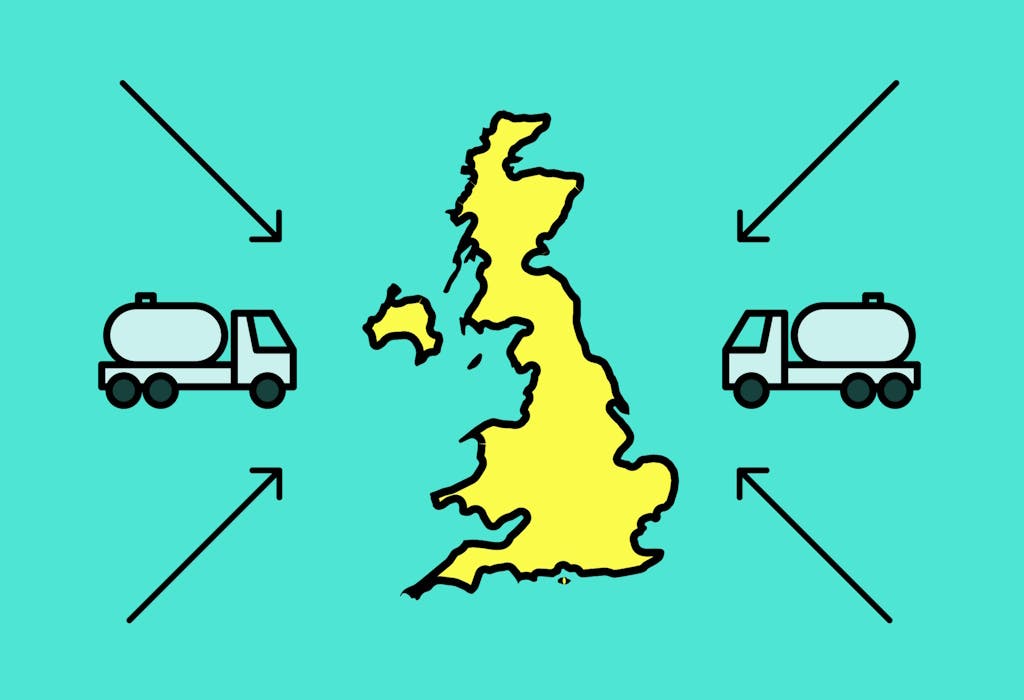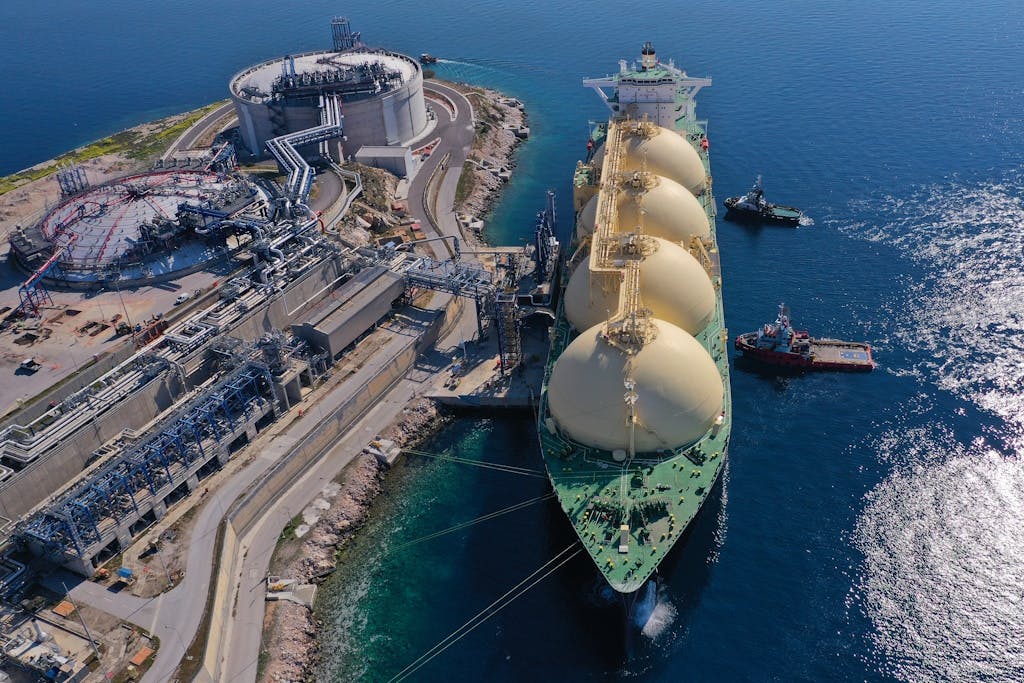Where does the UK get its gas from?
Here are all the countries that export gas to the UK, in order of importance – and how this is likely to change in the coming years.
Written byJosh Jackman

Calculate savings
What kind of home do you live in?
Calculate savings
What kind of home do you live in?
UK gas sources: at a glance
🚢 Norway is the UK’s biggest gas supplier
🌊 The North Sea provides just 33.8% of our gas
📉 UK gas consumption has dropped by 20% since 2021
The UK’s gas supply has fallen under the spotlight in recent years, as energy prices have soared and most European countries have moved away from importing from Russia.
Where we get our gas from – and how much of it we use – has a direct effect on the price of domestic gas and electricity.
In this guide, we’ll run through all the different countries that sell us gas, and explain the likely future of gas imports and consumption in the UK.
All our figures are based on gas import and export data published by the UK government in March and April 2025.
If you'd like to be somewhat protected from the effects that geopolitical turbulence regularly has on the price of gas, going solar is a great way to become more energy independent.
To see the savings you could get from a solar & battery system, just answer a few quick questions below, and we’ll provide an estimate.
The UK’s gas sources: explained
The UK uses a tremendous amount of gas, most of which we import.
Companies on these shores have produced gas for decades, but they don’t churn out enough to meet demand – and they export 35% of their supply to other countries.
This leaves the UK needing to import 66.2% of its gas supply, according to calculations we made using the latest government data – most of which comes from Norway and the US.
Below, you can see all of the UK’s gas sources, and how much of our supply they provide.
Map of the UK's gas sources, 2024
1. Norway
Norway keeps the UK running, providing 50.2% of our gas from its state-owned reserves.
That’s 76% of the gas we imported in 2023, continuing a streak that’s seen the Scandinavian country supply the majority of the UK’s gas imports for 24 of the past 25 years.
It is, by far, our most important gas supplier – and fortunately, one of our most stable relationships in this field. Any rift in this alliance would be catastrophic for the UK.
Norway sent 99.2% of this gas through pipelines in 2024, with the remaining 0.8% shipped over in the form of Liquefied Natural Gas (LNG).
The nation earned a total net profit of £6.6 billion in 2024 from its worldwide oil and gas exploits, which are majority-owned by its government.
2. The North Sea
The North Sea has provided the country with gas since 1966, and until 2004, it allowed the UK to be self-sufficient – but those days are long gone.
In 2024, sites in the area produced enough gas to supply 50% of the UK’s demand, according to the latest government reports.
More than one-third of that gas was exported, and we should get used to not having North Sea gas for too much longer.
The North Sea’s proven gas reserves – those with a 90% or better chance of being produced – have dwindled to 19% of what they were in 1996, according to our analysis of data from the Office for National Statistics (ONS).
There isn’t much more joy in probable reserves – which are more than 50% likely to be produced – or possible reserves, which have a 10-50% chance. Both have fallen to 10% of their 1996 levels.
The North Sea contains proven reserves of just 1,654TWh (terawatt-hours), so if we carry on extracting gas at the rate we did in 2024, we’ll run out of this supply in less than five years.
Even if all probable and possible reserves are fully plundered, we’ll still use up all our North Sea gas in less than a decade.
The latest gas licences handed out by the government will have a negligible effect on this, especially if they follow the average timeline of 28 years from licence to production.

3. US
In 16 of the 17 years up to 2017, the US supplied the UK with zero gas.
Over the next few years, we regularly imported LNG from the US, at a gradually increasing rate – until the energy crisis hit near the end of 2021.
The next year, the proportion of gas imports we sourced from the US jumped from 7.5% to 22.4%, and it rose again to 26% in 2023.
These LNG imports were crucial in eliminating our need for Russian gas and lessening our reliance on potentially unstable nations like Qatar.
And though this figure fell to 16.6% in 2024, it's still the third-highest amount of gas we've ever imported from the US.
4. Qatar
Our imports from Qatar have fallen in recent years, to the extent that it's barely holding on to its position as our third-biggest foreign supplier.
In 2011, we sourced 39.2% of our gas imports from the Middle Eastern state, but this figure has dropped over the years, and made up just 1.9% in 2024.
That’s the lowest proportion of our gas imports we’ve bought from Qatar since 2008 – when we didn't receive anything – and shows that the UK is moving away from relying on the controversial nation.
5. Trinidad and Tobago
The UK increased its LNG imports from Trinidad and Tobago by 55% in 2024, compared to 2023.
This made it 19 out of the past 20 years that the Caribbean nation has supplied us with gas, though our 2024 haul was the fifth-largest amount we've received.
Trinidad and Tobago is the largest LNG producer in South and Central America, despite being one of its smallest nations – it's around 2% the size of the UK – and is economically dependent on this revenue stream.
6. Algeria
Algeria is the UK’s oldest source of gas, including the North Sea.
We’ve been importing Algerian LNG since 1964, when the north African nation opened the Arzew Gas Terminal on its northern coast.
This LNG plant was one of the first in the world, coming two years before the North Sea started producing gas.
In the recent past, the peak in LNG relations between the two countries was 2006, when Algeria supplied 8.8% of the UK’s gas imports.
From 2005 to 2010, Algeria exported 64TWh of LNG to the UK – more than it sent between 2011 and 2024.
We’ve bought considerably more LNG from Algeria since the beginning of the energy crisis, though our imports are still nowhere near pre-2011 levels.
7. Angola
The UK started buying LNG from Angola in 2019, though imports only begun in earnest in 2022, when the southern African country leapfrogged Algeria in these rankings.
We received 56% less gas from Angola in 2024 than we did in 2023, meaning it went from supplying 1.8% of our imports to just 0.8%.
Angola’s LNG is entirely sourced from a coastal site in Soyo, in the north-west corner of the country.
Most of this gas is exported, the majority of which goes to European nations including the UK, France, and Spain.
8. Six other countries
From largest to smallest supplier, the rest of the UK’s gas comes from Peru, Nigeria, Belgium, Equatorial Guinea, Egypt, and the Netherlands.
Together, these nations provide 1.3% of our total gas consumption.
This is only the third year in which the UK has imported LNG from Equatorial Guinea, and the first time since 2019, but we have long relationships with most of the other countries.
Egypt and the Netherlands have supplied us with gas since 2006, we’ve imported LNG from Nigeria since 2010, and gas has flowed through the Interconnector pipeline from Zeebrugge in Belgium to Bacton in the UK since 1998.
At various points in recent years, Belgium and the Netherlands have provided the UK with substantial amounts of gas, but for the moment, we import relatively small amounts from them.
The UK started importing LNG from Peru's controversial Camisea gas fields in 2017, and more than doubled its intake when the energy crisis started, but cut its imports by 81% in 2024.
If you'd like to somewhat protect yourself from the effects that geopolitical events like the full-scale Russian invasion of Ukraine can have on your bills, going solar is a great way to become more energy independent.
To see the savings you could get from a solar & battery system, just answer a few quick questions below, and we’ll provide an estimate.
How much gas does the UK consume?
The UK consumes 687TWh of gas per year, according to the government’s latest report.
Since 1998, our gas consumption has fallen by 33% – but most of this reduction happened in 2011, 2022, and 2023.
Unfortunately, 2012 to 2021 was a lost decade, as we used the same amount of gas at both ends of this period.
The current level puts us in the top 11 highest gas-consuming countries in the world, ahead of large nations like India, Brazil, and France.
Reducing our gas usage is a crucial step towards cutting our energy bills, slashing our emissions, and becoming more energy independent.
UK gas demand, 1998-2024
Where will the UK get its gas from in the future?
The UK has consciously moved away from relying on a handful of gas exporters in the past few years – a trend we expect to intensify.
As well as opening up relationships with Angola and Equatorial Guinea, the UK has also sourced LNG from Chile, France, and Spain at times in the past five years.
The UK will likely keep diversifying its supply, while continuing to rely most heavily on the deep, stable reserves in Norway, particularly as the North Sea’s reserves run out.
Thankfully, gas consumption in the UK is dropping, lessening our need for imports.
Demand has fallen by 37% in the UK since 2010, and it’ll continue to decline as the country moves to fulfil its net zero obligations by replacing gas with renewable electricity.
Will the UK ever stop needing gas?
Legally, the UK must move away from using gas.
In 2019, our parliament passed a government bill into law that fixed the UK’s commitment to reach net-zero emissions by 2050.
Achieving this target will require every government from now until 2050 to move towards an energy network that’s based on renewable sources, while phasing out fossil fuels like gas.
This will lead to the electrification of everything from industry and transport to heating, with heat pumps, electric vehicles, and manufacturing machines all running on green electricity that we’ll generate with the likes of solar panels and wind turbines.
Reaching net zero doesn’t necessarily mean wiping out all sources of greenhouse gases, as this may prove impossible. The UK will offset emissions from completely unavoidable sources – but that doesn’t include gas.
Its roles in industry, the production of electricity, and heating can all be replaced. The time of gas is coming to a close.
Looking ahead
The UK gets most of its gas from Norway, the North Sea, and the US, in that order.
The North Sea’s supply is running low though, like many reserves – and as some countries run dry or move away from producing gas for environmental reasons, this will result in higher prices for everyone else.
Like all nations, the UK faces a choice: don’t address the issue and keep buying increasingly expensive gas from potentially unstable sources, or build renewable infrastructure like solar and wind farms.
Using our own green sources means reducing our reliance on imports, which will lower household energy bills and make us less vulnerable to geopolitical shifts.
If you'd like to use renewable energy instead of relying on global stability, going solar is a great way to cut your costs and guard against price spikes.
To see the savings you could get from a solar & battery system, just answer a few quick questions below, and we’ll provide an estimate.
UK gas sources: FAQs
Does the UK buy gas from Russia?
The UK doesn’t buy gas from Russia anymore.
In 2017, Russia started exporting Liquefied Natural Gas (LNG) to the UK, sending an average of 21.8TWh per year over the next few years.
But after Russia launched a full-scale invasion of Ukraine in February 2022, the UK cut off this supply line entirely.
Why is UK gas so expensive?
UK gas is expensive because it’s heavily influenced by the wholesale price, and because the great majority of our gas supply is imported.
This situation isn’t likely to change, as the UK’s gas facilities are limited and rapidly ageing out of usefulness.
The UK needs to either replace them or import more gas, both of which could cost billions of pounds that will be paid for through rises in household energy bills.
And as long as the country relies on gas, customers will be left vulnerable to geopolitical turbulence and global gas price rises, as shown by the recent energy crisis.
Does the UK export gas to Europe?
The UK exports gas exclusively to Europe.
In 2024, the UK exported 118TWh of gas to Belgium, the Netherlands, the Republic of Ireland, and the Isle of Man.
Belgium bought the most UK gas, importing 39.8% of this total, with the Republic of Ireland second on 37.9%, followed by the Netherlands on 21.3%. The Isle of Man received 1% of the UK's exported gas.

Written byJosh Jackman
Josh has written about the rapid rise of home solar for the past six years. His data-driven work has been featured in United Nations and World Health Organisation documents, as well as publications including The Eco Experts, Financial Times, The Independent, The Telegraph, The Times, and The Sun. Josh has also been interviewed as a renewables expert on BBC One’s Rip-Off Britain, ITV1’s Tonight show, and BBC Radio 4 and 5.